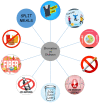Vaccine for Diabetes-Where Do We Stand?
- PMID: 36012735
- PMCID: PMC9409121
- DOI: 10.3390/ijms23169470
Vaccine for Diabetes-Where Do We Stand?
Abstract
Diabetes is an endocrinological disorder with a rapidly increasing number of patients globally. Over the last few years, the alarming status of diabetes has become a pivotal factor pertaining to morbidity and mortality among the youth as well as middle-aged people. Current developments in our understanding related to autoimmune responses leading to diabetes have developed a cause for concern in the prospective usage of immunomodulatory agents to prevent diabetes. The mechanism of action of vaccines varies greatly, such as removing autoreactive T cells and inhibiting the interactions between immune cells. Currently, most developed diabetes vaccines have been tested in animal models, while only a few human trials have been completed with positive outcomes. In this review, we investigate the undergoing clinical trial studies for the development of a prototype diabetes vaccine.
Keywords: GLP; clinical trials; diabetes; insulin; vaccines.
Conflict of interest statement
The authors declare no conflict of interest.
Figures
References
-
- Alwan A. Raising the priority accorded to diabetes in global health and development: A promising response. Int. J. Diabetes Mellit. 2010;3:139–140. doi: 10.1016/j.ijdm.2010.10.001. - DOI
-
- Diabetes. [(accessed on 1 June 2022)]. Available online: http://www.who.int/health-topics/diabetes#tab=tab_1.
Publication types
MeSH terms
Substances
Grants and funding
LinkOut - more resources
Full Text Sources
Medical




